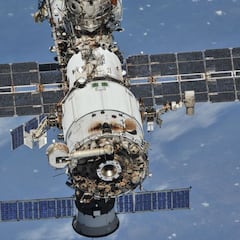India makes history: successfully launches the Chandrayaan-3 mission to discover the South Pole of the Moon
India’s second attempt to put a rover on the Moon will study the elements and minerals that make up the unexplored area. But the window to land is tight.

In the midst of the vast reaches of space, there is a mysterious and fascinating place that has aroused the curiosity of scientists and explorers: the unexplored South Pole of the Moon. To uncover the mysteries of this place, the Indian Space Research Organization (ISRO) launched its ambitious mission Chandrayaan-3 on Friday, a probe that is expected to land on the satellite between August 23 and 24, after the failed moon landing four years ago.
The mission, which left Earth weighing 8,600 lbs, is made up of three phases: a propulsor, in charge of getting the space craft to the Moon, where it will orbit some 62 miles above its surface, and which will serve as a satellite so that the team of scientists can communicate with the rest of the elements; a landing module, with which to go down to the lunar surface and is equipped with scientific instruments; as well a small rover with six wheels to explore the hitherto unknown lunar South Pole.
India aiming to be the fourth country in the world to land on the surface of the Moon
Putting a lander and a rover in the next 40 days on the moon’s south pole, a region unexplored to date, is a milestone that would allow India to enter the the exclusive club of countries that have managed to touch down on the Earth’s satellite: only the United States, Russia and China have succeeded.
For the ISRO, it is essential to meet the dates to get the most out of the scientific mission. That is because the instruments on board the rocket depend on sunlight to function, in such a way that our solar system’s star will begin to illuminate the area where the lander will arrive between on August 23 and 24 and will keep it illuminated for 14 Earth days, the equivalent of one lunar day.
Then, the area will remain in the shade for 14 days, at temperatures of up to 180 degrees below zero. By the time the sun shines again, scientists do not know if the instruments will continue to function properly. That is why the moon landing must take place at the moment the sun begins to illuminate the area and cannot be delayed.
What will they do if they don't reach the ground in time?
If the team detects at any point that the mission will not reach the ground in time, they will wait for the next window of opportunity (about 20 days later). During that time, Chandrayaan-3 will remain in orbit around the satellite.
In the 14 days available to collect data, the Indian rover, equipped with cameras to avoid obstacles, will exhaustively study the elements and minerals that make up the area to be explored. Additionally, the instruments equipped on the lander will analyze the technical properties of the lunar soil, and measure the satellite’s earthquakes and the density of electrons and ions near the surface.
Third lunar exploration mission
This is India’s third lunar exploration mission, after the subcontinental nation launched its first special mission to the Moon in 2008, Chandrayaan-1. In 2019 ISRO tried to land a probe on the south pole of the Moon with its second mission, Chandrayaan-2, but the mission failed and crashed on the Moon due to technical problems in its speed reduction when landing.
To improve upon its predecessor, the new probe has strengthened the lunar lander gear, and improved the software to have more tolerance for possible technical errors like the one that could have caused the failed moon landing four years ago.
lunar south pole
Unlike Earth, the Moon lacks a dense atmosphere and dynamic weather. Instead, its surface features craters, mountains and vast plains of moondust, offering a unique and challenging canvas for those who wish to venture beyond our terrestrial borders. And it is precisely at the lunar south pole where scientists believe that some of the most valuable keys to understanding the origin and evolution of our natural satellite are found.
Related stories
The lunar south pole is home to a large amount of unexplored territory, rich in geological features and unique phenomena. One of the most intriguing features is the presence of deep, dark craters that never see sunlight. In these polar craters, scientists suspect there may be reservoirs of water in the form of ice, trapped in the permanent shadows.
This potentially revolutionary find could provide crucial resources for future space missions, alleviating the need to transport water from Earth and enabling sustainable lunar exploration. In addition to its possible water content, the Moon’s south pole also has other intriguing features that will be of interest to explore.

